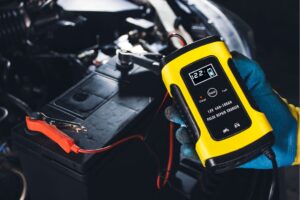It’s fair to say you wouldn’t get very far in your motorhome without batteries. After all, your batteries power the electricity that allows you to turn on your engine. You want your batteries to last as long as possible, so do they need maintenance?
RV batteries require maintenance, including regular cleaning, refilling, and testing to ensure they’re in operable condition. Regularly maintaining your batteries can increase their lifespan to five or six years. Without maintenance, the batteries my only last year for a year or two.
Many RV owners don’t know the first thing about maintaining their batteries and certainly don’t do it often enough. I’ll tell you everything you need to start incorporating batteries into your maintenance routine so you can extend the life of your batteries and save some cash.

RV Battery Maintenance – Prioritize These Tasks
Clean the Batteries
You might be reading this wondering what I’m talking about. Cleaning the batteries? Shouldn’t batteries and water never mix?
Not at all! Many types of motorhome batteries are filled with water, as I’ll discuss in just a moment. You can and should keep the batteries clean using water and baking soda.
Before you get started, turn off your RV and disconnect the batteries. Make sure you disconnect the leads to two terminals rather than one to be on the safe side.
Next, take the batteries out of their housing or mounting location. This will allow you to see the entirety of the batteries and all the gunk that’s likely built up, especially if you’ve never cleaned the batteries before.
That gunk is battery acid, which can impede how well your batteries work. It’s removable and doesn’t require a heavy-duty cleaner like you might imagine.
You need six parts water to one part baking soda. Yes, that’s it! Use filtered or distilled water, as tap water could have metals and other substances that could degrade the batteries.
Stir the ingredients until no more baking soda residue is left. Transfer the cleaner into a spray bottle and mist the battery terminals. Allow at least five minutes to elapse for the baking soda to do its job and remove the battery acid and debris.
Then take a wet rag and wipe down the batteries on all sides. Double-check that you have no baking soda residue on the batteries, as that will affect how they function.
You can use a cleaning brush for baked-on grime and gunk, but ensure it’s designed for battery terminals. A harsh brush will destroy the leads and prevent your batteries from working.
Put the batteries back into their terminal when you’re satisfied with their cleanliness, turn your motorhome power back on, and begin using your batteries.
Refill the Batteries

Most RVs use deep-cycle flooded lead acid batteries. Other types of batteries you might come across are gel cell, absorbent glass mat, and lithium ion. Flooded lead acid batteries require refilling.
These batteries are filled with water and sulfuric acid. Lead plates within the battery sit submerged in these substances. When you charge the battery, the water and sulfuric acid react and produce gas, which is then vented out.
However, the gas production decreases the electrolytes, which is why these batteries can lose fluid.
How do you know when it’s time to refill your deep-cycle flooded lead acid batteries? If you can see the lead plates, that indicates it’s more than time.
You don’t need to worry about topping off the sulfuric acid levels in the battery (and thank goodness for that), only water. Use distilled or deionized water and never tap water.
Many RV batteries will have refilling instructions. You might have to disconnect the battery from its power source and then refill it, but this isn’t always required. The instructions will tell you exactly what to do and recommend the precise fill level.
Going forward, check the fluid levels in your motorhome batteries at least monthly and top them off as required.
Keep the Vent Cap on When Charging
The vent cap fits on top of the battery cell and comes off so you can check the electrolyte levels inside. Most RV owners assume that the vent cap has to stay off when recharging the battery to prevent overheating.
However, that isn’t the case. Keeping the vent cap secure when you charge your battery can limit the amount of off-gassing that occurs when sulfuric acid and water interact.
This will retain the fluid levels in the battery longer, allowing you to wait weeks and sometimes even months before refilling with water.
Charge the Batteries

Let’s talk further about charging RV batteries, as a big determinant of their lifespan is how well you charge them. And yes, there is a correct and incorrect way to recharge motorhome batteries.
A three-stage process utilized by converter chargers will get your RV battery back to 100 percent.
First, employ a bulk charge over several hours until your battery reaches 90 percent. Next, follow that up with an absorption charge until you hit the last 10 percent and your battery is fully charged.
This method reduces water loss because you’re not gassing the batteries as much. If you need to keep the full charge for a while, use a float charger.
Keep the battery voltage at 10.5 volts at least when charging. I’ll explain why that’s important later, but tuck it in the back of your mind for now.
Avoid Battery Overcharging
Have you ever plugged in your phone to charge it, meant to unplug it before you went to bed, but fell asleep before you could? You probably woke up the next morning in a panic, right?
After all, you’re always told not to charge a battery for too long. There’s a reason for that, by the way. Energy can continually enter the cell when you overcharge, allowing the cell’s voltage to rise beyond intended levels.
The battery could overheat, which is probably the worst-case scenario. Just as bad is the loss of long-term life.
These side effects occur in lithium batteries the most frequently, but you still shouldn’t overcharge other types of motorhome batteries. You’ll slash their lifespan.
Deep discharging is just as detrimental. The battery cells decrease in performance each time you do it. The battery won’t last as long, and in some instances, it can even swell.
Store the Batteries
Some motorhome owners are fortunate enough to travel in their vehicles all year long. For everyone else, there’s a break of several months over the winter.
How and where do you store your batteries when idle will go a long way toward ensuring they work in the spring.
Charge your batteries to 100 percent before you store them. This might seem silly because you’re not going to use your RV for a while. However, the full charge accommodates for discharging.
All batteries discharge, which is a slow depletion of the battery life even when you’re not using it. Fully charging your motorhome battery prevents it from discharging too low.
However, one charge will not last you the entire winter. Store your battery where you can access it and test its levels once per month. Charge the battery up to 100 percent if its power level drops below 75 percent.
An RV battery should never be left to discharge past 50 percent, so diligence is critical. Check the fluid levels and refill as necessary. You must still use deionized or distilled water.
Your batteries are now ready for storage. Keep them in a dry, cool environment that doesn’t surpass 80 degrees or drop below 32 degrees Fahrenheit. Don’t store the batteries in direct sunlight.
Monitoring Warm Temperatures
This next point isn’t a maintenance tip so much as it’s a best practice, so it’s still good to remember as you began caring for your RV batteries.
Higher temperatures cause the batteries to deplete faster, and deep-cycle batteries will lose fluid just as quickly.
Continuing to use the batteries can cause damage severe enough that you might shorten their life.
Be ultra-diligent about fluid levels in the heat, refilling much more frequently than every 30 days. You might have to top off the water levels several times a week depending on how hot the temperatures are.
What if you’re traveling through a region where it’s hot only sometimes? A warm day will still zap the batteries of electrolytes, so make sure you check the batteries before you plan long-distance travel. You don’t want to find yourself stranded!
Use Your Battery Disconnect Switch
Parasitic loads can increase a battery’s discharge rate.
Many of the common appliances and electronics in your motorhome can contribute to the parasitic load, from stereos to clocks and gas leak detectors. Even the circuit boards that power your appliances do it.
So what are your options here, either stop using these items or deal with discharge? Fortunately, there’s a third option most RV owners will find much more appealing.
Many motorhome batteries include a disconnect switch. The switch can prevent parasitic loads from causing premature discharge, but it must be turned off.
However, you should only turn the switch off when you’re storing or otherwise not in your motorhome.
Watch 12-Volt Battery Discharge Rates
Okay, let’s talk more about 12-volt batteries, as promised.
A 12-volt battery technically runs over 12 volts if you fully charge it. It’s operating at 12.7 volts. Therefore, it’s at half its battery when it reaches the 12-volt level.
Tracking how much voltage a 12-volt RV battery has requires a voltmeter. You can also learn more about the discharge rate through the voltmeter.
Use a Battery Bank
You don’t want to have to forego electricity and other necessities because of battery issues, right? A battery bank is like a backup in case one battery suddenly goes kaput.
I recommend at least one extra battery, but two is fine if you want to be doubly safe. Please check your motorhome owner’s manual to determine if it can accommodate more than one battery, but I would bet it can, no problem. Most RVs can.
However, if your vehicle can only support an additional battery, don’t add a third. That’s a recipe for disaster.
A battery bank requires like batteries. The batteries should all be the same type, voltage, and model. It’s not enough to have two models from the same brand, as other differences between the batteries are likely.
You can use jumper wires to connect the first battery to its new companion or a second and third battery to the first one.
You must maintain all the batteries moving forward, which means replacing fluid levels as required and managing discharge.
Keep Up Regular Maintenance
Even if you’ve never taken care of your batteries before, you can start today and make a huge difference in the longevity of the batteries your RV has now. Regular maintenance will improve longevity.
Recycle Your Batteries
Even if you care for your motorhome batteries regularly, the time will inevitably come when you must get rid of them because they no longer work (or work well). However, don’t throw them away!
Instead, recycle them. Battery lead is usually recyclable, with about 95 percent of the lead repurposed. Battery plastic can also get a new life, so please, contact your local recycling center and discuss your options.
Bottom Line
If you replace your RV batteries every year, you’re not caring for them properly. A good set of batteries should last five or six years on average, but even the best batteries won’t work well by themselves. They require maintenance.
Keeping your batteries clean will go a long way toward improving their functionality. You also need to know when to charge them, how, and for how long. When storing your RV batteries for the off-season, watch where you keep them.
Monitor the battery life, as it will discharge when idle, and refill deep-cycle lead-acid batteries. Once you begin doing these simple tasks, your batteries will reward you by keeping your motorhome illuminated and ready to ride for many years.
